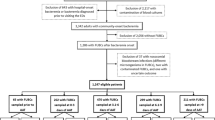Abstract
Time-to-positivity (TTP) is defined as the length of time from the beginning of culture incubation to the detection of bacterial growth by an automated system. The objective of this study was to assess the clinical and microbiological implications of TTP among patients with Gram-negative bacilli (GNB) bacteremia. This was a prospective, single-center, observational study. Patients aged 18 years or older with one or more blood cultures growing GNB were included and followed until hospital discharge or death. Patients were excluded if they were without symptoms of infection, if they had polymicrobial culture, or if the culture was positive with an obligate anaerobe. A multivariate logistic regression analysis was performed to determine the predictors of in-hospital mortality, including TTP (primary endpoint), demographics, disease severity, comorbidities, pathogen type, source of infection, time to symptom resolution, hospital/intensive care unit (ICU) length of stay, adequacy of empiric antibiotics, and presence of an extended-spectrum beta-lactamase (ESBL)-producing bacteria. One hundred consecutive patients with GNB bacteremia were enrolled. TTP was an independent predictor of mortality; for every hour that TTP was shorter, the risk of mortality increased by 10 % [odds ratio (OR) 1.10, 95 % confidence interval (CI) 1.00–1.21, p = 0.049]. Other predictors of mortality included severity of illness, ESBL-producing GNB, and ICU admission within 24 h before culture. Mortality was highest among patients with inadequate empiric therapy (56 % vs. 14 %, p < 0.001) and TTP <11 h (23.1 % vs. 8.3 %, p = 0.18). Lactose-fermenting GNB had a shorter mean TTP than non-lactose fermenters (11.4 vs. 17.9 h, p = 0.001). Among patients with bacteremia due to GNB, TTP values are inversely associated with mortality risk.


Similar content being viewed by others
References
Rogers MS, Oppenheim BA (1998) The use of continuous monitoring blood culture systems in the diagnosis of catheter related sepsis. J Clin Pathol 51:635–637
Liao CH, Lai CC, Hsu MS, Huang YT, Chu FY, Hsu HS, Hsueh PR (2009) Correlation between time to positivity of blood cultures with clinical presentation and outcomes in patients with Klebsiella pneumoniae bacteraemia: prospective cohort study. Clin Microbiol Infect 15:1119–1125
Khatib R, Riederer K, Saeed S, Johnson LB, Fakih MG, Sharma M, Tabriz MS, Khosrovaneh A (2005) Time to positivity in Staphylococcus aureus bacteremia: possible correlation with the source and outcome of infection. Clin Infect Dis 41:594–598
Peralta G, Rodríguez-Lera MJ, Garrido JC, Ansorena L, Roiz MP (2006) Time to positivity in blood cultures of adults with Streptococcus pneumoniae bacteremia. BMC Infect Dis 6:79
Peralta G, Roiz MP, Sánchez MB, Garrido JC, Ceballos B, Rodríguez-Lera MJ, Mateos F, De Benito I (2007) Time-to-positivity in patients with Escherichia coli bacteraemia. Clin Microbiol Infect 13:1077–1082
Marra AR, Edmond MB, Forbes BA, Wenzel RP, Bearman GML (2006) Time to blood culture positivity as a predictor of clinical outcome of Staphylococcus aureus bloodstream infection. J Clin Microbiol 44:1342–1346
Martínez JA, Soto S, Fabrega A, Almela M, Mensa J, Soriano A, Marco F, Jimenez de Anta MT, Vila J (2006) Relationship of phylogenetic background, biofilm production, and time to detection of growth in blood culture vials with clinical variables and prognosis associated with Escherichia coli bacteremia. J Clin Microbiol 44:1468–1474
Martínez JA, Pozo L, Almela M, Marco F, Soriano A, López F, Balasso V, Aguilar J, Mensa J (2007) Microbial and clinical determinants of time-to-positivity in patients with bacteraemia. Clin Microbiol Infect 13:709–716
Blot F, Schmidt E, Nitenberg G, Tancrède C, Leclercq B, Laplanche A, Andremont A (1998) Earlier positivity of central-venous- versus peripheral-blood cultures is highly predictive of catheter-related sepsis. J Clin Microbiol 36:105–109
Passerini R, Riggio D, Radice D, Bava L, Cassatella C, Salvatici M, Zorzino L, Sandri MT (2009) Interference of antibiotic therapy on blood cultures time-to-positivity: analysis of a 5-year experience in an oncological hospital. Eur J Clin Microbiol Infect Dis 28:95–98
Potential conflicts of interest
The authors declare that they have no conflict of interest.
Author information
Authors and Affiliations
Corresponding author
Rights and permissions
About this article
Cite this article
Palmer, H.R., Palavecino, E.L., Johnson, J.W. et al. Clinical and microbiological implications of time-to-positivity of blood cultures in patients with Gram-negative bacilli bacteremia. Eur J Clin Microbiol Infect Dis 32, 955–959 (2013). https://doi.org/10.1007/s10096-013-1833-9
Received:
Accepted:
Published:
Issue Date:
DOI: https://doi.org/10.1007/s10096-013-1833-9




